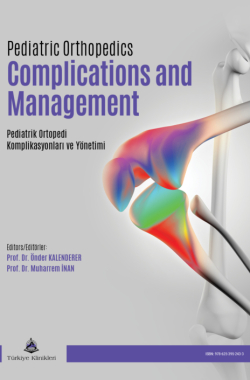Complications of Hip Surgery in Neuromuscular Patients
Hakan ŞENARANa , İlker Abdullah SARIKAYAb
aBezmiâlem Vakıf University Faculty of Medicine, Department of Orthopedics and Traumatology, İstanbul, Türkiye
bOTA Jinemed Hospital, Clinic of Orthopedics and Traumatology, İstanbul, Türkiye
Şenaran H, Sarıkaya İA. Complications of hip surgery in neuromuscular patients. In: Kalenderer Ö, İnan M, eds. Pediatric Orthopedics Complications and Management. 1st ed. Ankara: Türkiye Klinikleri; 2024. p.134-8.
ABSTRACT
Managing hip joint pathologies in children with neuromuscular disease requires well-organized planning and a careful treatment program. However, even when planning, treatment, and followup are appropriate, hip surgery in neuromuscular patients is highly prone to complications. It has been demonstrated that severely affected neuromuscular patients who underwent femoral and/or pelvic osteotomies have a significantly higher rate and different types of complications. The aim of this chapter is to address the complications related to the management of the hip in neuromuscular disease, especially in cerebral palsy and spina bifida. The leading complications are recurrent dislocation, wound infection, fixation failure, nonunion, avascular necrosis, and heterotopic ossification.
Keywords: Neuromuscular disease; hip surgery; complication; cerebral palsy; spina bifida
Kaynak Göster
Referanslar
- Sarikaya IA, Birsel SE, Erdal OA, Görgün B, Şeker A, İnan M. Treatment of Hip Dislocation in Cerebral Palsy with Extraarticular Intervention. Acta Chir Orthop Traumatol Cech. 2023;90(2):92-9. English. [Crossref]
- DiFazio R, Vessey JA, Miller P, Van Nostrand K, Snyder B. Postoperative Complications After Hip Surgery in Patients With Cerebral Palsy: A Retrospective Matched Cohort Study. J Pediatr Orthop. 2016;36(1):56-62. [Crossref] [PubMed]
- Davids JR. Management of Neuromuscular Hip Dysplasia in Children With Cerebral Palsy: Lessons and Challenges. J Pediatr Orthop. 2018;38 Suppl 1:S21-S7. [Crossref] [PubMed]
- Sankar WN, Spiegel DA, Gregg JR, Sennett BJ. Long-term follow-up after one-stage reconstruction of dislocated hips in patients with cerebral palsy. J Pediatr Orthop. 2006;26(1):1-7. [Crossref] [PubMed]
- Rutz E, Vavken P, Camathias C, Haase C, Jünemann S, Brunner R. Long-term results and outcome predictors in one-stage hip reconstruction in children with cerebral palsy. J Bone Joint Surg Am. 2015;97(6):500-6. [Crossref] [PubMed]
- Bayusentono S, Choi Y, Chung CY, Kwon SS, Lee KM, Park MS. Recurrence of hip instability after reconstructive surgery in patients with cerebral palsy. J Bone Joint Surg Am. 2014;96(18):1527-34. [Crossref] [PubMed]
- Alman BA, Bhandari M, Wright JG. Function of dislocated hips in children with lower level spina bifida. J Bone Joint Surg Br. 1996;78(2):294-8. [Crossref] [PubMed]
- Bartonek A, Saraste H, Samuelsson L, Skoog M. Ambulation in patients with myelomeningocele: a 12-year follow-up. J Pediatr Orthop. 1999;19(2):202-6. [Crossref] [PubMed]
- Shobeiri P, Presedo A, Karimi A, Momtazmanesh S, Vosoughi F, Nabian MH. Orthopedic management of myelomeningocele with a multidisciplinary approach: a systematic review of the literature. J Orthop Surg Res. 2021;16(1):494. [Crossref] [PubMed] [PMC]
- Dhawale AA, Karatas AF, Holmes L, Rogers KJ, Dabney KW, Miller F. Long-term outcome of reconstruction of the hip in young children with cerebral palsy. Bone Joint J. 2013;95-B(2):259-65. [Crossref] [PubMed]
- Dick AG, Magill N, White TCH, Kokkinakis M, Norman-Taylor F. C-reactive protein: what to expect after bony hip surgery for nonambulatory children and adolescents with cerebral palsy. J Pediatr Orthop B. 2019;28(4):309-313. [Crossref] [PubMed]
- Okuzu Y, Tsukanaka M, Kuroda Y, Goto K, Futami T, Matsuda S. Early Breakage of All Proximal Locking Compression Screws under Non-weight-bearing Conditions after Derotational Femoral Osteotomy in a Child with Cerebral Palsy: A Case Report. J Orthop Case Rep. 2021;11(12):1-4. [Crossref]
- Amen J, Perkins O, Kafchitsas K, Reed D, Norman-Taylor F, Kokkinakis M. Bony hip reconstruction for displaced hips in patients with cerebral palsy: Is postoperative immobilization indicated? J Child Orthop. 2023;17(3):268-75. [Crossref] [PubMed] [PMC]
- Hosseinzadeh P, Baldwin K, Minaie A, Miller F. Management of Hip Disorders in Patients with Cerebral Palsy. JBJS Rev. 2020;8(3):e0148. [Crossref] [PubMed]
- Inan M, Chan G, Dabney K, Miller F. Heterotopic ossification following hip osteotomies in cerebral palsy: incidence and risk factors. J Pediatr Orthop. 2006;26(4):551-6. [Crossref] [PubMed]
- Bauer JP, Sienko S, Roy D, Nye D, Tarrant S, Price R, et al. The incidence of avascular necrosis in children with cerebral palsy after hip containment surgery. J Child Orthop. 2022;16(6):454-60. [Crossref] [PubMed] [PMC]
- Phillips L, Hesketh K, Schaeffer EK, Andrade J, Farr J, Mulpuri K. Avascular necrosis in children with cerebral palsy after reconstructive hip surgery. J Child Orthop. 2017;11(5):326-33. [Crossref] [PubMed] [PMC]
- Kumba C, Gaume M, Barbarian A, Péjin Z. Intraoperative Goal-Directed Therapies in Femoral and Pelvic Osteotomies in Children and In-Hospital Postoperative Outcomes. Research Square. 2021. [Crossref]
- Sherrod BA, Baker DK, Gilbert SR. Blood Transfusion Incidence, Risk Factors, and Associated Complications in Surgical Treatment of Hip Dysplasia. J Pediatr Orthop. 2018;38(4):208-16. [Crossref] [PubMed] [PMC]

